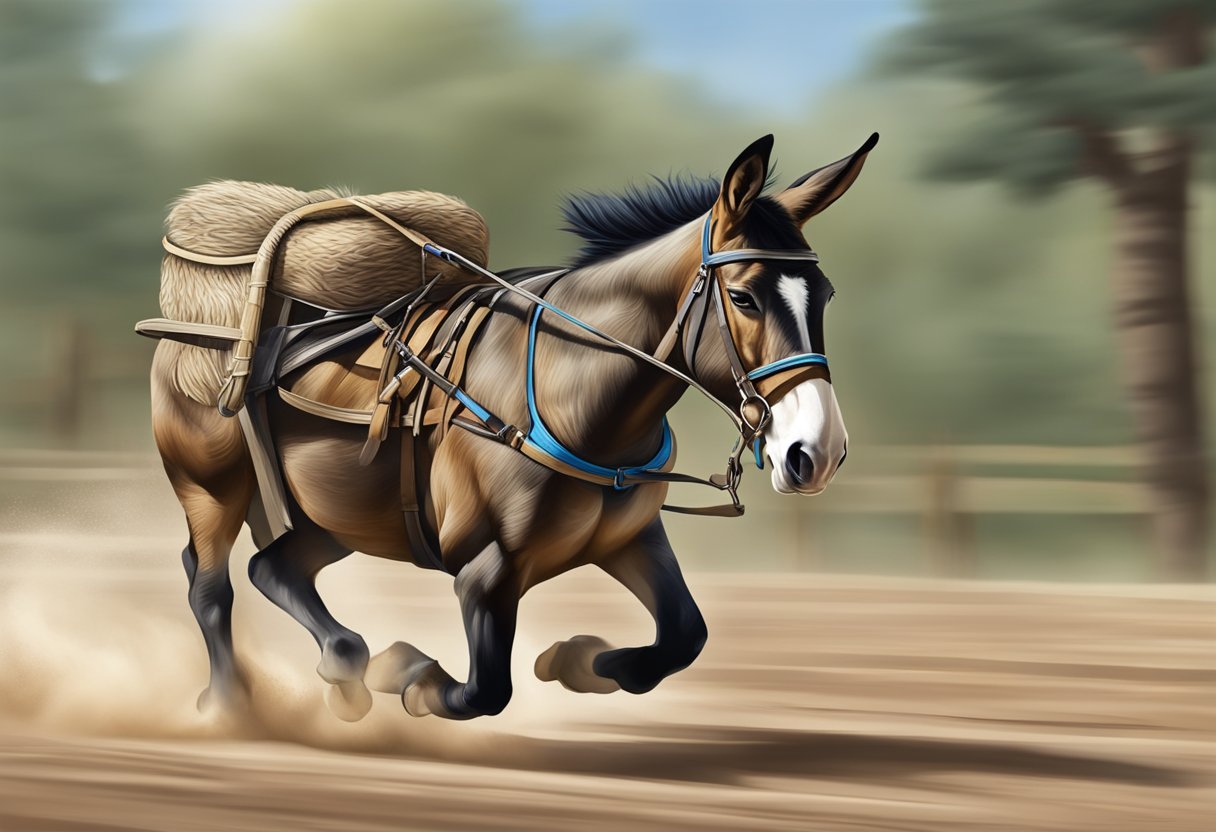Mules are fascinating creatures that have been used as work animals for centuries. They are the result of crossbreeding between a male donkey and a female horse, and they inherit certain characteristics from both parents. One of the most interesting aspects of mules is their speed. Many people wonder how fast a mule can run and what factors influence their speed.
Mule Speed Basics Mules are known for their strength and endurance, but they are not typically considered to be fast animals. On average, a mule can run at speeds of up to 15 miles per hour. This is slower than the average speed of a horse, which can run at speeds of up to 30 miles per hour. However, mules are still capable of covering long distances at a steady pace, which makes them ideal for certain types of work.
Factors Influencing Mule Speed There are several factors that can influence the speed of a mule. One of the most important is their build. Mules have shorter legs and a heavier body than horses, which can make it more difficult for them to run quickly. Other factors that can affect their speed include their age, health, and training. Mules that are well-trained and in good health are more likely to be able to run at their maximum speed for longer periods of time.
Key Takeaways
- Mules are not typically considered to be fast animals, with an average speed of up to 15 miles per hour.
- Factors that can influence a mule’s speed include their build, age, health, and training.
- Although mules may not be the fastest animals, they are still capable of covering long distances at a steady pace, making them ideal for certain types of work.
Mule Speed Basics
Mules are known for their strength and endurance, but how fast can they run? The answer is not straightforward, as it depends on various factors such as breed, age, training, and physical condition.
On average, a healthy adult mule can travel at speeds of up to 15 miles per hour AZ Animals. However, some mules have been known to run even faster, up to 20-25 miles per hour over short distances EAdventure.
It is important to note that mules are not typically used for racing, unlike horses. However, they can still cover long distances at a steady pace. A mule can travel at about 5 to 8 miles per hour over longer distances Fulkwest.
Factors that can affect a mule’s speed include its weight, the terrain it is running on, and the weather conditions. Additionally, mules are known for their intelligence and stubbornness, which can sometimes affect their performance.
Factors Influencing Mule Speed

Mules are known for their strength, endurance, and speed. However, the speed of a mule can be influenced by various factors. This section will discuss some of the factors that can affect the speed of a mule.
Breed
The breed of a mule can have an impact on its speed. Mules that are bred from faster horses and donkeys are likely to be faster than those bred from slower ones. For example, mules bred from Thoroughbred horses and large donkeys are known to be faster than those bred from smaller donkeys.
Age
Age is another factor that can affect the speed of a mule. Younger mules tend to be faster than older ones. This is because younger mules have more energy and are more agile than older ones. However, older mules that are well-trained can still be quite fast.
Health
The health of a mule can also influence its speed. Mules that are in good health and have no injuries or illnesses are likely to be faster than those that are not. Injuries or illnesses can cause a mule to slow down or even stop altogether.
Training
Training is perhaps the most important factor that can affect the speed of a mule. A well-trained mule can run faster and more efficiently than one that is not. Training can improve a mule’s endurance, agility, and speed. Mules that are trained for specific tasks, such as racing or jumping, are likely to be faster than those that are not.
In conclusion, the speed of a mule can be influenced by various factors, including breed, age, health, and training. Mule owners should take these factors into consideration when training and caring for their animals.
Comparison with Other Animals
Mule vs Horse
When it comes to speed, horses have the upper hand over mules. Horses are built for speed, and they can run at an average speed of around 30 miles per hour, while mules max out at around 15 miles per hour. This is because horses have longer legs and a more streamlined body, which allows them to run faster.
Mule vs Donkey
Mules are a cross between a horse and a donkey, so it’s natural to wonder how they compare to their donkey parent. Donkeys are slower than horses, and they have a top speed of around 15 miles per hour. Mules, on the other hand, can run at the same speed as their donkey parent. However, mules are stronger and more durable than donkeys, which makes them better suited for carrying heavy loads.
Overall, mules are not the fastest animals out there, but they have other qualities that make them valuable. They are strong, durable, and have a good temperament, which makes them ideal for working in the fields or carrying heavy loads.
Impact of Speed on Work Efficiency

Mules are known for their strength and endurance, but how fast can they actually run? The answer to this question depends on several factors, including the mule’s age, size, and overall health. However, it’s important to note that increasing speed can have a negative impact on work efficiency.
According to a study on muscular efficiency during steady-rate exercise, increasing speed led to a decrease in efficiency. This is because the body has to work harder to maintain a faster pace, which can lead to fatigue and reduced performance. Therefore, it’s important to find a balance between speed and work rate to maximize efficiency.
In terms of mules specifically, they are generally not as fast as horses. While mules demonstrate greater strength in pulling and carrying capacity, horses excel in other areas, such as speed and endurance. Horses are generally faster and have better stamina, making them ideal for activities like racing or long-distance riding.
That being said, mules can still run at a decent pace. The average speed of a mule is around 3-5 miles per hour, with some mules capable of running up to 7 miles per hour. However, it’s important to keep in mind that pushing a mule to run at their maximum speed for extended periods of time can lead to decreased work efficiency and potential health issues.
Speed Management and Training Techniques
Training a mule for speed requires a well-planned program that focuses on building endurance, strength, and agility. The training program should be tailored to the individual mule’s needs and abilities while keeping in mind the owner’s goals.
One effective technique for speed management is interval training. This involves alternating periods of intense exercise with periods of rest or low-intensity activity. According to Verywell Fit, incorporating high-intensity interval training can help improve a mule’s fitness and speed.
Another key aspect of speed management is proper nutrition and hydration. Mules require a balanced diet that provides the necessary nutrients to support their physical activity. Adequate hydration is also essential, especially during hot weather or intense exercise.
In addition to interval training and proper nutrition, it is important to incorporate strength training exercises into the mule’s training program. This can include hill work, resistance training, and exercises that target specific muscle groups. These exercises can help improve the mule’s power and speed.
Finally, a successful speed management program requires patience, consistency, and a positive training environment. Mules respond well to positive reinforcement and should be rewarded for progress and good behavior.
Frequently Asked Questions
What is the top speed of a mule?
A well-trained and healthy riding mule can reach a top speed of 20-25 miles per hour, which is comparable to a horse of similar size and breed. However, some mules have been known to run even faster, up to 30-35 miles per hour, under the right conditions.
How does the speed of a mule compare to a horse?
A well-trained horse can run faster than a mule. While mules can run at the speed of 35 miles/hour, a well-trained horse can cover around 45 miles/hour.
Are mules faster than donkeys?
Yes, mules are faster than donkeys. Mules inherit the speed of their horse parent and can run faster than donkeys.
Can a mule outrun a horse?
No, a mule cannot outrun a horse. Horses are faster than mules, and even a well-trained and healthy mule cannot outrun a horse.
How do mule and horse temperaments compare?
Mules are known for their intelligence and calm temperament. They are less likely to panic than horses and are often described as more sure-footed and less skittish. However, this can vary depending on the individual animal and its training.
Are mules safer to ride than horses?
Mules are generally considered to be safer to ride than horses. They are more sure-footed and less prone to panicking, which can make them a good choice for inexperienced riders or those who are nervous about riding. However, as with any animal, it is important to choose a well-trained and properly cared for mule for riding.
Conclusion
Mules are known for their endurance and strength. They are capable of carrying heavy loads for long distances without getting tired. A healthy adult mule can run at an average speed of 15 mph (24 kph) . However, the speed of a mule can vary depending on various factors such as age, weight, and terrain.
Mules are generally slower than horses, but they are more sure-footed and have better endurance. They are ideal for long-distance trail riding, hunting, and packing . Mules are also used for racing, but they are not as fast as horses.
In conclusion, mules are strong and versatile animals that can run at a decent speed. They are ideal for endurance activities and can carry heavy loads for long distances without getting tired. Mules are not as fast as horses, but they make up for it with their endurance and sure-footedness.











































